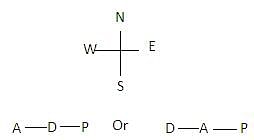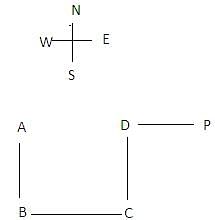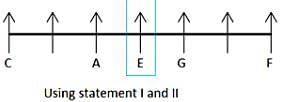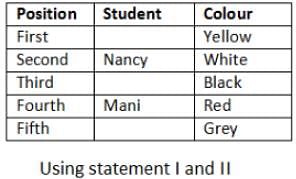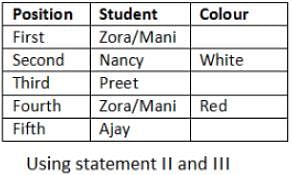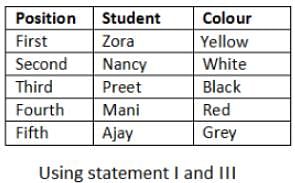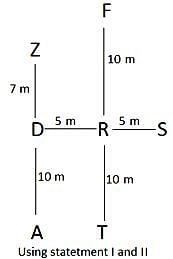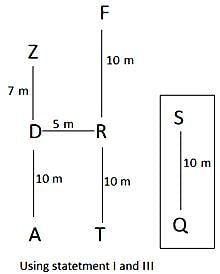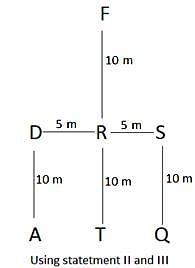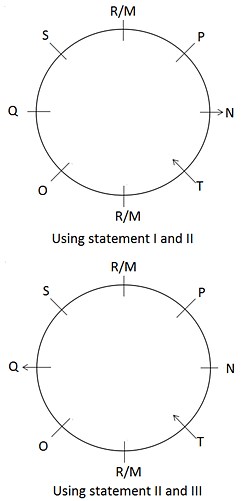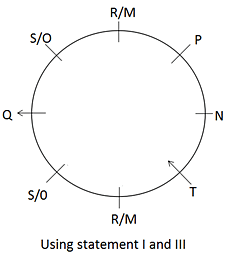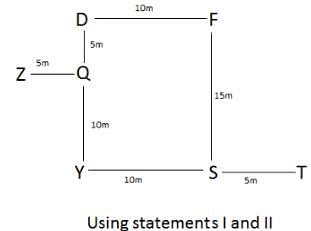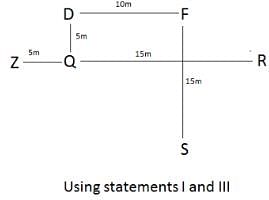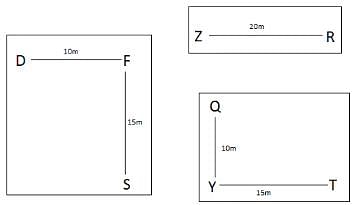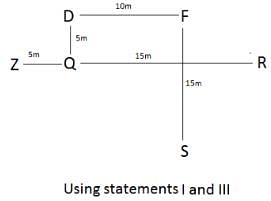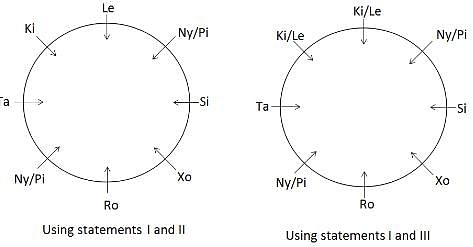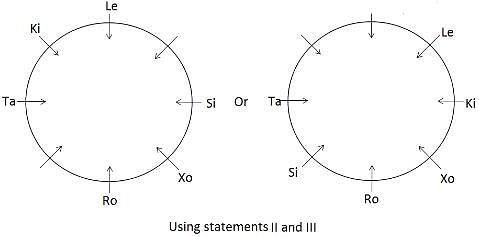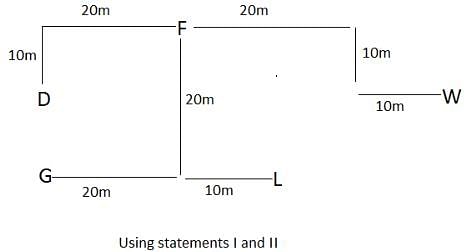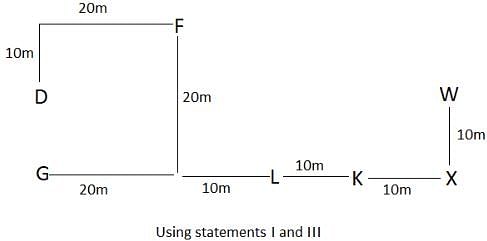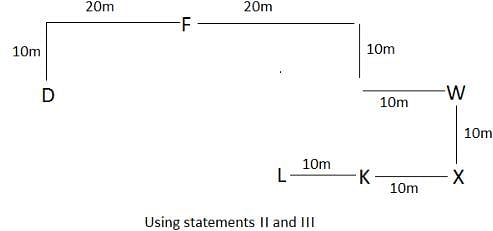Test Level 3: Data Sufficiency - 1 - CAT MCQ
10 Questions MCQ Test - Test Level 3: Data Sufficiency - 1
Directions: This problem consists of a question followed by two statements numbered I and II given below it. Read the statements carefully and decide which of them is/are sufficient/necessary to answer the question.
Mark your answer as
a. if the data in statement I alone is sufficient to answer the question, while the data in statement II alone is not sufficient to answer the question
b. if the data in statement II alone is sufficient to answer the question, while the data in statement I alone is not sufficient to answer the question
c. if the data in either of the statements alone is sufficient to answer the question
d. if the data in both statements I and II together is not sufficient to answer the question
e. if the data in both statements I and II together is necessary to answer the question
Q. What is the direction of A with respect to D?
I: A is to the north of B, which is to the west of C, which is to the south of D.
II: D is to the west of P, which is to the east of A.
Mark your answer as
a. if the data in statement I alone is sufficient to answer the question, while the data in statement II alone is not sufficient to answer the question
b. if the data in statement II alone is sufficient to answer the question, while the data in statement I alone is not sufficient to answer the question
c. if the data in either of the statements alone is sufficient to answer the question
d. if the data in both statements I and II together is not sufficient to answer the question
e. if the data in both statements I and II together is necessary to answer the question
II: D is to the west of P, which is to the east of A.
Directions: This problem consists of a question followed by two statements numbered I and II given below it. Read the statements carefully and decide which of them is/are sufficient/necessary to answer the question.
Mark your answer as
a. if the data in statement I alone is sufficient to answer the question, while the data in statement II alone is not sufficient to answer the question
b. if the data in statement II alone is sufficient to answer the question, while the data in statement I alone is not sufficient to answer the question
c. if the data in either of the statements alone is sufficient to answer the question
d. if the data in both statements I and II together is not sufficient to answer the question
e. if the data in both statements I and II together is necessary to answer the question
Q. In a test, P, Q, R, S and T obtained different scores - 10, 14, 16, 15, 20. The average score of all 5 persons is equal to the score of R alone. Which person obtained the highest score?
I. Sum of scores of S and T is 30 and that of Q and P is 30.
II. P scored more than T and sum of scores of Q and S is 24.
Mark your answer as
a. if the data in statement I alone is sufficient to answer the question, while the data in statement II alone is not sufficient to answer the question
b. if the data in statement II alone is sufficient to answer the question, while the data in statement I alone is not sufficient to answer the question
c. if the data in either of the statements alone is sufficient to answer the question
d. if the data in both statements I and II together is not sufficient to answer the question
e. if the data in both statements I and II together is necessary to answer the question
II. P scored more than T and sum of scores of Q and S is 24.
| 1 Crore+ students have signed up on EduRev. Have you? Download the App |
Directions: The following problem consists of a question and three statements (I), (II) and (III) given below it. You have to find out which of the statements is/are redundant for determining the answer to the given question or can be dispensed with.
A, B, C, D, E, F and G are sitting on a single bench facing North. C is second to the left of A. C is not the immediate neighbour of E.
Q. Who is sitting exactly in the middle?
I. G is second to the left of F, who is not an immediate neighbour of C.
II. E is the immediate neighbour of A.
III. B is the immediate neighbour of G and F.
A, B, C, D, E, F and G are sitting on a single bench facing North. C is second to the left of A. C is not the immediate neighbour of E.
I. G is second to the left of F, who is not an immediate neighbour of C.
II. E is the immediate neighbour of A.
III. B is the immediate neighbour of G and F.
Directions: In the following problem, a question followed by three statements (I), (II) and (III) is given. You have to determine which statement(s) is/are sufficient/necessary to answer the question.
Five students participated in a race wearing t-shirts of different colours i.e. black, white, yellow, red and grey. Their names are Zora, Ajay, Nancy, Mani and Preet. Nancy finished the race second. The student wearing red t-shirt finished the race fourth.
Q. What is the colour of the t-shirt, which Preet was wearing during the race?
I. Student wearing white t-shirt finished the race immediately after the student wearing yellow t-shirt. Mani finished the race immediately after the one wearing black t-shirt.
II. One, who finished the race at first place was not wearing grey t-shirt. The one who stood third was not wearing yellow t-shirt.
III. Two persons finished the race between Zora and Mani. Preet finished the race immediately after the student wearing white t-shirt.
Directions: In the following problem, a question followed by three statements (I), (II) and (III) is given. You have to determine which statement(s) is/are sufficient/necessary to answer the question.
A is 10 m to the South of D, who is 5 m to the West of R.
Q. What is the position of T with respect to S?
I. Z is 7 m to the North of D. T is 10 m to the South of R.
II. S is 5 m to the East of R, who is 10 m to the South of F.
III. F is 20 m to the North of T. S is 10 m to the North of Q.
Directions: In the following problem, a question followed by three statements (I), (II) and (III) is given. You have to determine which statement(s) is/are sufficient/necessary to answer the question.
A 7 storey building has the ground floor marked as first floor and top floor marked as seventh floor. Seven persons live on different floors of the building. U lives on sixth floor.
Q. Who lives on the top floor?
I. R lives on even numbered floor and P lives on the floor which is three floors above the floor of R.
II. S is living on the floor, which is immediately below the floor of P. Q lives on a floor, which is above the floor of S.
III. R lives on the floor, which is two floors below the floor of S. T does not live on any floor above the floor of R.
Directions: The following question is accompanied by statements (I), (II) and (III). You have to determine which statement(s) is/are sufficient/necessary to answer the question.
Friends M, N, O, P, Q, R, S and T are sitting around a circular table at equal distances. Some of them are facing centre and some are facing outwards. T is facing centre and Q is third to the left of T. N is not the immediate neighbour of Q.
Q. Is O sitting on the immediate left of Q?
I. S is third to the left of N. O is the immediate neighbour of Q.
II. O and P are sitting fourth to each other. N is the neighbour of P.
III. P is third to the right of Q. R and M are sitting fourth to each other.
Directions: In the following problem, a question followed by three statements (I), (II) and (III) is given. You have to determine which statement(s) is/are sufficient/necessary to answer the question.
D is 10 m to the West of F, which is 15 m to the North of S.Q. In which direction is R with respect to F?I.
Q is 5 m to the South of D. Z is 5 m to the West of Q.
II. Q is 10 m to the North of Y, which is 15 m to the West of T.
III. Z is 20 m to the West of R.
Directions: The question given below is followed by three statements (I), (II) and (III). You have to determine which of the statements is/are sufficient/necessary to answer the question.
Eight persons Ny, Xo, Ta, Le, Pi, Si, Ki and Ro are sitting around a circular table at equal distances facing the centre, but not necessarily in the same order. Ta is third to the left of Xo, who is the immediate right neighbour of Ro.
Q. What is the position of Ta with respect to Si?
I. Ny is sitting opposite to Pi.
II. Ki is third to the right of Si.
III. Le and Ki are immediate neighbours.
Directions: The following question is accompanied by three statements (I), (II) and (III). You have to determine which statements are sufficient/necessary to answer the question.
If D walks 10 m towards north then takes right turn and walks another 20 m, then he will meet F.
Q. In which direction is F with respect to X?
I. If F walks 20 m towards south then takes right turn, then he will meet G at the distance of 20 m. G is 30 m to the west of L.
II. If W walks 10 m towards west, takes right turn and walks 10 m more and then takes left turn, then he will meet F at the distance of 20 m.
III. X is 10 m to the south of W and 10 m to the east of K, who is 10 m to the east of L.




